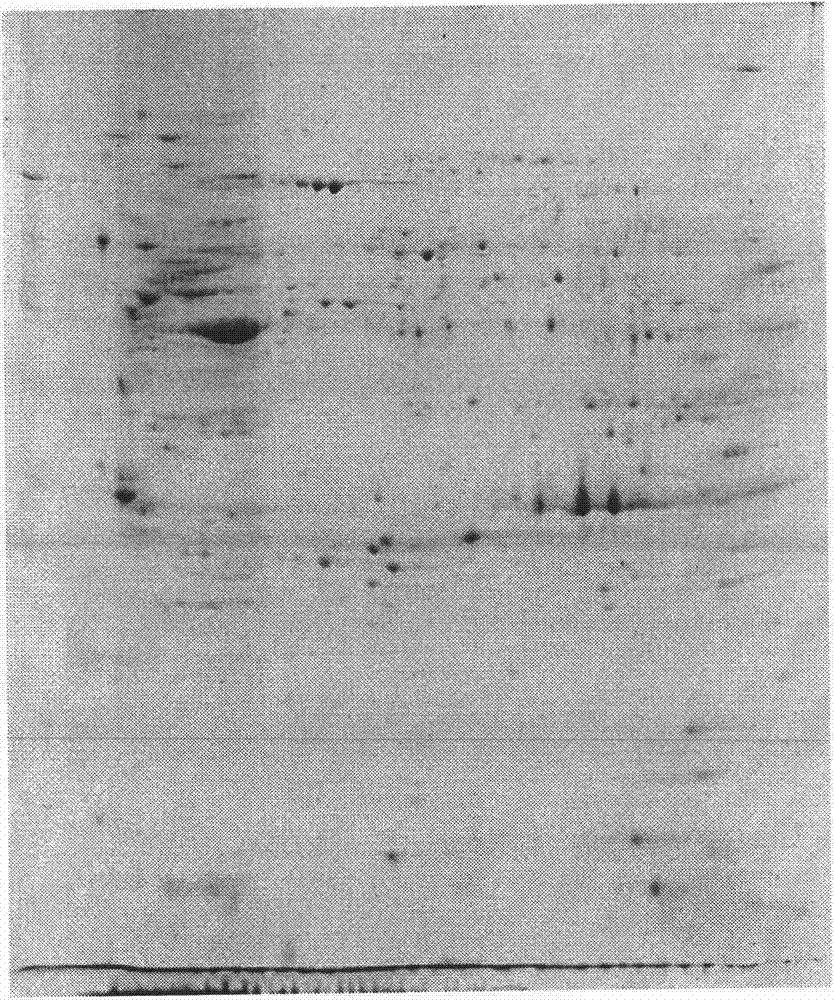Extraction method of total protein from rumen epithelial tissue of milk cow
A technology of epithelial tissue and extraction methods, applied in the fields of peptide preparation, chemical instruments and methods, organic chemistry, etc., can solve problems such as the lag of proteome research, and achieve the effect of obvious integrity and visualization
- Summary
- Abstract
- Description
- Claims
- Application Information
AI Technical Summary
Problems solved by technology
Method used
Image
Examples
Embodiment 1
[0032] 1. Extraction of total protein samples from rumen epithelial tissue
[0033] 1) Separate the cow rumen epithelial tissue, cut it into small pieces with a sterile scalpel, place it in a pre-cooled mortar, add liquid nitrogen and grind it to powder, and transfer the tissue powder to a centrifuge tube.
[0034] 2) Add pre-cooled 10% trichloroacetic acid in acetone solution (every 1 L of acetone contains 0.1 kg trichloroacetic acid) into the centrifuge tube, vortex and mix well, and place it overnight at -20°C. Then centrifuge at 10000×g for 15 min, discard the liquid phase, and collect the precipitate A.
[0035] 3) Add 4 times the volume of 80% cold acetone solution (each 1 L of solution contains 0.8 L of acetone and 0.2 L of water) to the tissue precipitate A, vortex fully, place at -20 ° C for 1 h, and then pass through 10000 × Centrifuge at g for 15 min, discard the liquid phase, and collect the precipitate B.
[0036] 4), lyophilize the tissue precipitate B, add an ...
Embodiment 2
[0054] 1. Extraction of total protein samples from rumen epithelial tissue
[0055] 1) Separate the cow rumen epithelial tissue, cut it into small pieces with a sterile scalpel, place it in a pre-cooled mortar, add liquid nitrogen and grind it to powder, and transfer the tissue powder to a centrifuge tube.
[0056] 2) Add pre-cooled 10% trichloroacetic acid in acetone solution 5 times the volume of tissue powder into the centrifuge tube, shake and vortex to mix, place at -20°C overnight, then centrifuge at 10000×g for 15min, discard the liquid phase fraction, collect the precipitate A.
[0057] 3) Add 5 times the volume of 80% cold acetone solution to the tissue precipitate A, vortex fully, place at -20°C for 2 hours, then centrifuge at 10,000×g for 15 minutes, discard the liquid phase, and collect the precipitate B.
[0058] 4) Freeze-dry the tissue pellet B, add an equal volume of lysate containing 8mol / L urea, 2mol / L thiourea, 4% CHAPS, 100mmol / L Triton X-100 and 65mmol / L ...
Embodiment 3
[0076] 1. Extraction of total protein samples from rumen epithelial tissue
[0077] 1) Separate the cow rumen epithelial tissue, cut it into small pieces with a sterile scalpel, place it in a pre-cooled mortar, add liquid nitrogen and grind it to powder, and transfer the tissue powder to a centrifuge tube.
[0078] 2) Add pre-cooled 10% trichloroacetic acid in acetone solution 3 times the volume of tissue powder into the centrifuge tube, shake and vortex to mix, place at -20°C overnight, then centrifuge at 10000×g for 15min, discard the liquid phase fraction, collect the precipitate A.
[0079] 3) Add 3 times the volume of 80% cold acetone solution to the tissue precipitate A, vortex fully, place at -20°C for 0.5h, then centrifuge at 10000×g for 15min, discard the liquid phase, and collect the precipitate B .
[0080] 4) Freeze-dry the tissue pellet B, add an equal volume of lysate containing 8mol / L urea, 2mol / L thiourea, 4% CHAPS, 100mmol / L Triton X-100 and 65mmol / L dithiot...
PUM
 Login to View More
Login to View More Abstract
Description
Claims
Application Information
 Login to View More
Login to View More - R&D
- Intellectual Property
- Life Sciences
- Materials
- Tech Scout
- Unparalleled Data Quality
- Higher Quality Content
- 60% Fewer Hallucinations
Browse by: Latest US Patents, China's latest patents, Technical Efficacy Thesaurus, Application Domain, Technology Topic, Popular Technical Reports.
© 2025 PatSnap. All rights reserved.Legal|Privacy policy|Modern Slavery Act Transparency Statement|Sitemap|About US| Contact US: help@patsnap.com

